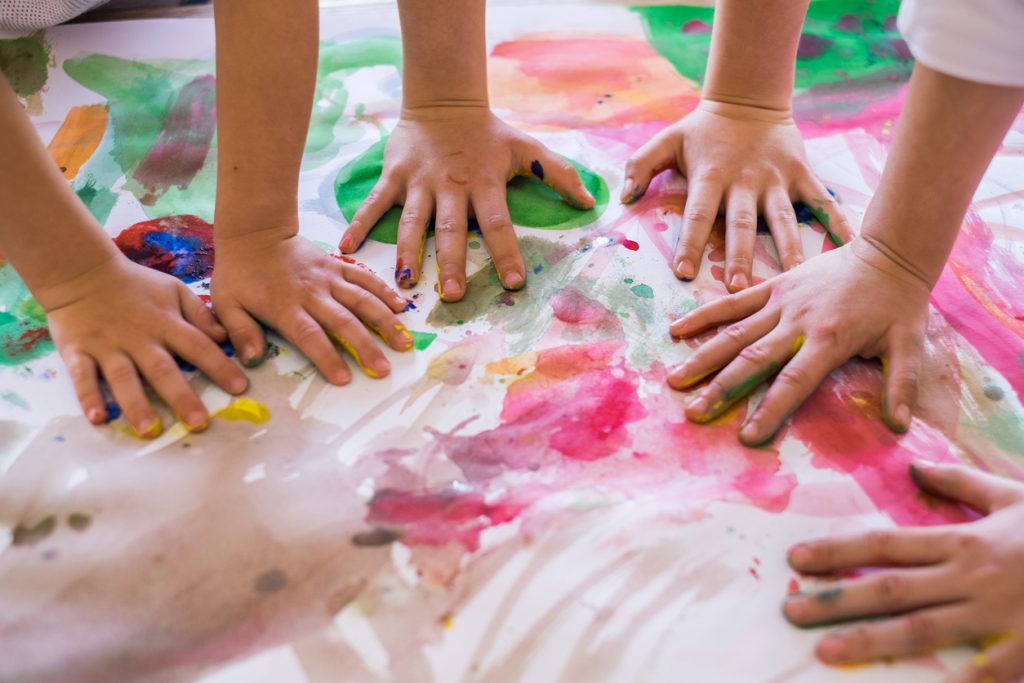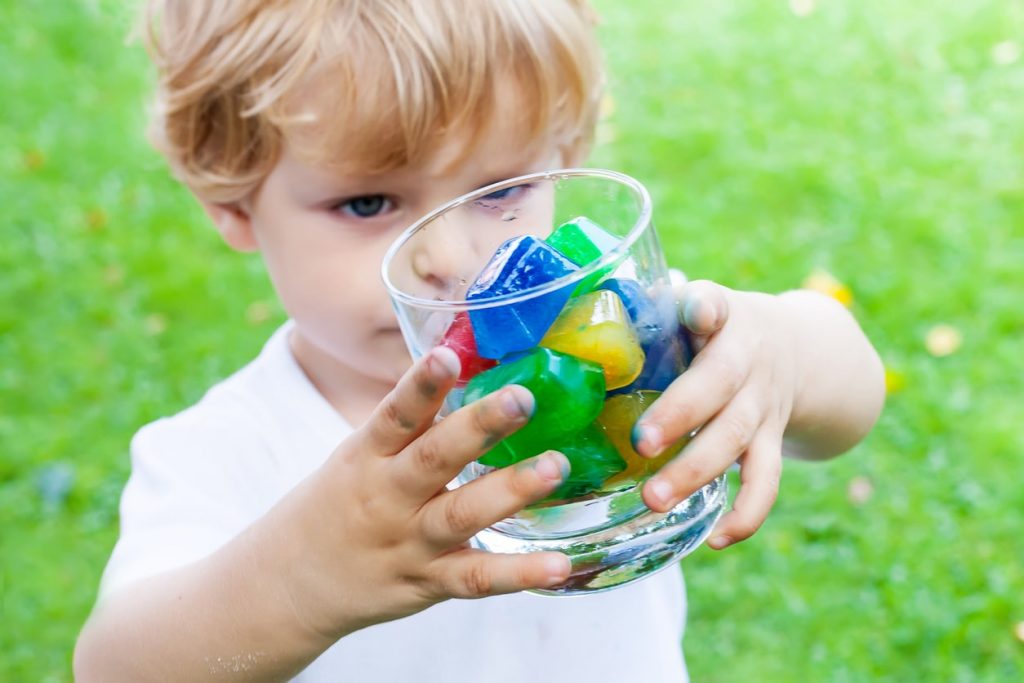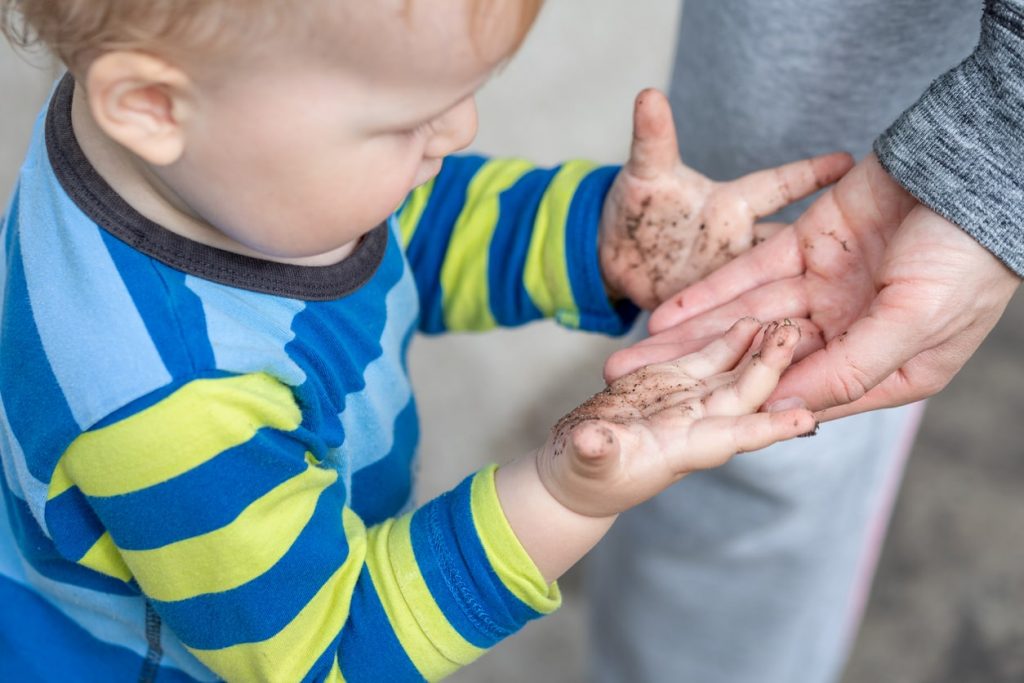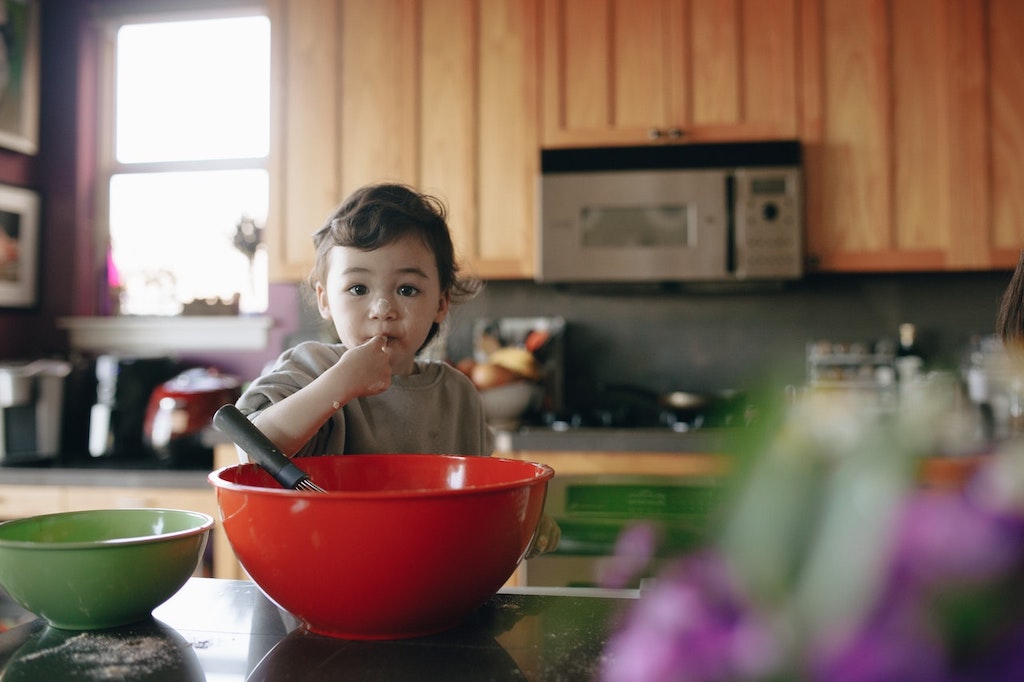Whether you embrace the joy messy play brings or perhaps find the clean up a little bit of a headache – one thing is for sure, messy play is always a hit with the children!
Doing messy play is really helpful to a child’s development, improving both their cognitive and motor skills. You can start messy play from a really young age to encourage your baby to become familiar with it.
By choosing from some of our age appropriate messy play activities for your baby or toddler, you’ll be helping them to gain the confidence to join in and have fun.
Top Tips for Setting up your Messy Play
Here are some useful ideas for setting up a successful messy play activity:
Pick a time of day when your baby or toddler isn’t hungry or tired. After breakfast or lunch can be a good window to help them get the most out of your messy play activity
Get organised. Try and gather all the different elements you need for the activity in advance so that it’s ready to go as soon as you’re all ready to start. This may include dressing them in clothes that you don’t mind getting messy.
Go outdoors if you can. This is a great way to avoid having to worry about your home getting messy and allows your child to enjoy the fresh air at the same time.
Find a spot inside. If the outdoors isn’t an option, try using a water table, a large plastic sheet or even your bathtub as an area where your child can create a mess without any stress!
Age Appropriate Messy Play: Our Guide
6 – 9 months
Babies all differ in what developmental milestones they will have reached by this stage, so try to be relaxed about things and adapt activities to your baby’s individual needs.
Some babies may be weaning by this stage and interested in exploring tastes and textures, which can be a real benefit with messy play. Foods such as yoghurt or pureed vegetables (yes, we said it would be messy!) are perfect tools to use.
There will be differences in whether babies will be sitting up easily at this age so do feel free to adapt the activities or use cushions to securely prop your baby up if required.
1. Reaching for Bubbles

You’ll have noticed that your baby loves to reach for things and may have been doing this for a few months now. Bubbles are a great way to engage their interest and the way that they move and float can be mesmerising for children and adults alike.
Always remember to keep bubbles away from children’s eyes and ensure that you keep them out of reach when not using them!
2. Squelching Mud
Babies love to explore new textures and feel them in their hands. Squeezing and squelching natural materials such as mud can help them strengthen the tiny muscles in their hands.
You can either use mud from your garden and add a little water to it or perhaps use some sand with water instead.
3. Enjoying Water Play
Even at 6 months old, water play is a brilliant way to entertain babies. It’s also an ideal way of making sure they feel happy and confident in water and that they enjoy things like being washed at bath time.
You don’t need much to make water fun – even just a few bowls, a kitchen colander or a few plastic cups will keep babies entertained. You could try gently sprinkling it on their hands first to introduce them slowly.
4. Playing with Ice Cubes
Ice cubes are an excellent tool for messy play and babies will be fascinated by the temperature of them. Let them explore them gradually – take their lead. You may want to think about putting them in a bowl of water to make them less cold initially.
At 6-9 months your baby probably won’t do much more than simply handling the ice cubes, picking them up and maybe exploring them with their mouths. This is good preparation for extending the messy play to filling and emptying containers when they’re slightly older.
5. Exploring Paints

Many parents like to take a footprint or hand print of their baby during their first year to create a beautiful memory. Why not extend this into a fun messy play activity? It can get pretty messy though so ensuring your baby is just wearing a nappy is the best approach!
Make sure you use paints that are suitable for baby sensitive skin, and always wash off the paint thoroughly after use.
9 – 12 months
As your child gets closer to 1 year old, you’ll notice them really starting to engage with and enjoy messy play.
They’ll probably start to move around – either by crawling or even walking – during this time so they will suddenly be gaining access to all sorts of new experiences.
At this age they also really start to explore their independence so are likely to love any type of messy play activities that they can do themselves.
6. Shake the Box
One of the less messy options you might consider with babies close to reaching one year old is to fill a clear plastic box with objects.
You could either go for objects such as slime or jelly that will be kept inside of the container, or you could use it to explore nature items such as stones, which will rattle.
Shaking the box will be good to engage your baby’s hearing and you could try hiding it under a rug and seeing if they can follow the sound.
7. Exploring Natural Materials
Getting your baby outdoors at least once a day is brilliant for their health – giving them fresh air and plenty of Vitamin D. You can use natural materials such as sand, mud or wood chippings to create messy play activities.
If you need to be indoors, try using a container placed on a plastic mat for your child to explore the natural materials. You could always switch to collecting up leaves or feathers if mud and sand are too messy for indoor play.
8. Making Food Fun

As your baby reaches 1 year old they’re probably getting much more confident exploring food – the tastes, the colours, the textures. So why not incorporate trying some of the elements of messy play into dinner time?
We’re not suggesting wasting food by simply playing with it, but instead using meal times to explore food colours, flavours and textures. It’s a brilliant way of introducing new foods in a fun and stimulating way for your child.
Encourage your baby to use their hands to feel the food (fruits and vegetables are especially good to use), but also to smell them and lick them. Oranges and citrus fruits are excellent for engaging the sense of smell.
9. Filling and Emptying Containers
Hot and cold are concepts that children start to understand earlier than we often think.
Messy play can be a natural lead into helping your child associate cold with elements such as ice. It’s super simple to set up and you can just use standard ice cubes or crushed ice in a tray. Children will enjoy playing with ice, and if they try to eat it, the benefit is it will help with hydration!
10. Understanding Ice

Hot and cold are concepts that children start to understand earlier than we often think.
Messy play can be a natural lead into helping your child associate cold with elements such as ice. It’s super simple to set up and you can just use standard ice cubes or crushed ice in a tray. Children will enjoy playing with ice, and if they try to eat it, the benefit is it will help with hydration!
12 – 18 months
Your baby is fast turning into a toddler and they will probably be communicating with hand gestures, nods and grunting – as well as maybe trying out some real words.
This can be an exciting time to interact with your child and messy play gets even more fun. Try making your instructions clear and concise – you’ll be surprised how well they can follow them!
12-18 month olds also tend to love everyday household items like colanders and wooden spoons, so you can always incorporate these into your play.
11. Mark Making with a Crayon

Lay out large sheets of paper on the floor and offer your child some thick crayons which are easy to grip.
If your child is unsure about what to do, start to draw shapes yourself and they’ll quickly follow your lead. They may start to hand you crayons in a gesture that shows they want you to draw, or they may prefer to mark make themselves.
Offer lots of praise and encouragement any time they make a mark – they’ll love it.
12. Using Cookie Cutters with Playdough
Playdough is a brilliant messy play activity and you can either buy it pre made or find easy recipes online. Your child will love to feel the playdough and you can simply let them mould it with their hands or offer items such as a rolling pin or cookie cutters.
Get cookie cutters in the shape of animals, numbers, vehicles or anything else your child enjoys identifying – this is a natural and easy way to extend the activity.
13. Sieving Flower Petals in Water
This is a fun way to develop fine motor skills alongside engaging your child with water play.
Collect some fallen flower petals with your child and place them in water. Show them how they float on the surface and allow them to reach in and move them around.
Extend the activity by offering them a sieve to see if they can catch the petals as they move around.
14. Make a Mud Kitchen

Mud kitchens can offer hours of fun for children and it’s a really wholesome setting for exploring messy play. Making a mud kitchen in your backyard is also ideal for when you have friends come to visit – children love to interact with others and make up games.
Let your child engage with the mud kitchen on a free play basis – they’ll quickly hone in on areas that they enjoy. You could demonstrate how to fill a container with mud and tip it out, but there doesn’t need to be a set activity here.
15. Water Painting on a Mat or Outside on Patio
If you have a patio and it’s a warm day, grab a paintbrush and some water and head outside. Don’t have a paintbrush? You can just do hand prints instead.
Children love painting with water and it can be a little less messy than getting out paints. It’s also a great way to cool down in the middle of summer. If you don’t have a backyard, you can easily buy special mats designed for water painting.
18 months – 2 years
You’ll really notice your child’s development when you compare the type of ‘messy play’ activities that they can now do at 18 months onwards.
Progressing from simply playing with purees and food, your child may now be enthusiastic about helping you in the kitchen with actual tasks or basic cooking.
16. Baking Cookies (or at least stirring the bowl)

Cooking with children is messy, but it’s a super way to get them interested in food and understanding where food comes from.
Try to choose easy recipes such as cookies and if your child is still developing their gross motor skills, you may want to give them a separate bowl to mix with less contents to avoid total mess!
Your child will probably be watching you to learn how to do everything, so this can be a lovely bonding activity.
17. Making Greetings Cards with Hand and Finger Printing
Relatives and friends will love receiving a personalised card from you and your child with hand, feet or finger prints on. You could do this at Christmas, Easter or for birthday cards.
Make sure you use paints that are suitable for children’s skin and introduce the idea of painting their hands and feet slowly so that they feel comfortable.
18. Freezing Toys in Ice Blocks
Your child can actually help you set up this messy play activity as well as participating in it. Ask them to find some of their favourite small plastic toys and place them carefully into ice cube trays or zip loc bags.
Fill with water and put in the freezer (discussing with your child how this turns water into ice). Once they’re frozen, your child will be fascinated to see how the figures are inside the ice and watch them begin to melt.
19. Block Printing with Unwanted Vegetables
This is a really fun activity that will enhance your child’s understanding of a healthy lifestyle, whilst getting creative too. It uses unwanted or overripe vegetables which would otherwise be put into food waste.
Choose vegetables such as broccoli florets and halved potatoes so that their textures vary. Dip them in paint and use them like rubber stamps to print onto paper or card.
20. Getting in the Garden

Whether it’s simply asking your child to help you with a small watering can, or setting up an activity such as planting seeds, getting in the garden is a lovely messy play activity.
Talk to your child about plants needing water and sunshine – they’ll love learning about this, and point out insects, bugs or birds to engage them with nature.
As you can see, there are so many ways you can engage your baby or toddler in messy play at home. Planning your activity ahead of time in a ‘mess friendly’ area of the home using age appropriate elements are key to creating an enjoyable time for all.
Keep your phone handy as there’s sure to be some funny moments to be captured to share with your family and friends!
If you would like some additional ideas for messy play at home, feel free to talk to our Educators who will be happy to share some experiences we often create at our Stepping Stone (SA) Childcare & Early Development Centres.







